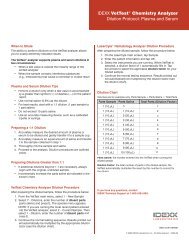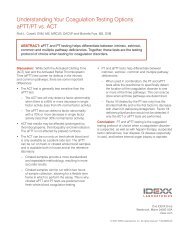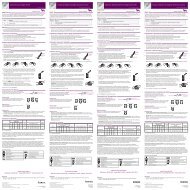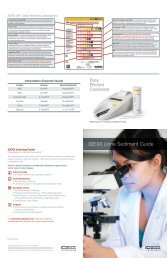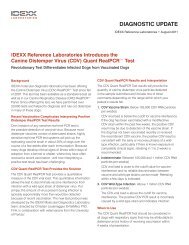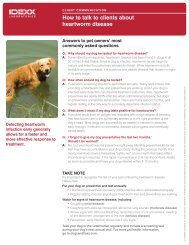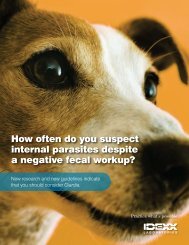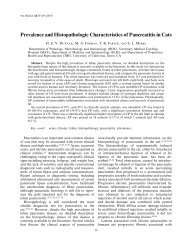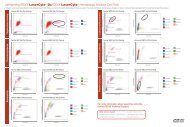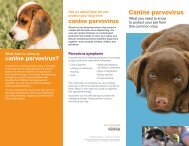SMALL ANIMALS/EXOTICFigure 1—Box and whisker plot <strong>of</strong> serum NT-proBNP concentration<strong>in</strong> dogs <strong>in</strong> which the etiology <strong>of</strong> respiratory signs is congestiveheart failure (group 1; n = 62), primary respiratory tract disease(group 2; 21), and respiratory tract disease with concurrentheart disease (group 3; 27). For each plot, the box representsthe IQR, the horizontal l<strong>in</strong>e <strong>in</strong> the middle <strong>of</strong> the box representsthe median, and the whiskers denote the range extend<strong>in</strong>g to 1.5times the IQR from the upper and lower quartiles. Outlier valuesbetween 1.5 to 3.0 times the IQR are denoted as squares. *Significantly(P < 0.005) different from value for group 1 dogs.Tricuspid regurgitation was detected <strong>in</strong> 34 (34/62[55%]), 5 (5/21 [24%]), and 18 (18/27 [67%]) group1, 2, and 3 dogs, respectively. A diagnosis <strong>of</strong> pulmonaryhypertension was made for 16 (16/62 [26%]) group 1dogs (mean ± SD tricuspid regurgitation velocity, 3.78± 0.49 m/s; n = 16), 7 (7/21 [33%]) group 2 dogs (4.69± 0.89 m/s; 5), and 5 (5/27 [19%]) group 3 dogs (4.27 ±0.60 m/s; 5). Median (IQR) serum NT-proBNP concentration<strong>in</strong> group 2 dogs with pulmonary hypertensionwas significantly (P = 0.002) higher than <strong>in</strong> group 2dogs without pulmonary hypertension (1,028 pmol/L[559 to 1,829 pmol/L] vs 309 pmol/L [196 to 461 pmol/L], respectively). In contrast, median (IQR) serum <strong>NTproBNP</strong>concentration <strong>in</strong> group 1 dogs with pulmonaryhypertension was not significantly (P = 0.41) higherthan <strong>in</strong> group 1 dogs without pulmonary hypertension(2,078 pmol/L [1,484 to 3,071 pmol/L] vs 2,541 pmol/L [1,539 to 3,141 pmol/L], respectively). Also, median(IQR) serum NT-proBNP concentration <strong>in</strong> group 3 dogswith pulmonary hypertension was not significantly (P =0.81) higher than <strong>in</strong> group 3 dogs without pulmonaryhypertension (478 pmol/L [348 to 1,616 pmol/L] vs504 pmol/L [301 to 1,107 pmol/L], respectively).Univariate regression analysis revealed that serumNT-proBNP concentration was significantly but poorlycorrelated to body weight (r = 0.21; P = 0.029), VHS(r = 0.55; P < 0.001), LVIDs <strong>in</strong>dexed to body weight(r = 0.27; P = 0.021), and LA:Ao (r = 0.61; P < 0.001).Multiple regression analysis revealed that only LA:Ao(β coefficient = 757.9; P < 0.001) and VHS (β coefficient= 218.3; P = 0.043) were correlated with serumNT-proBNP concentration.Figure 2—The ROC curve display<strong>in</strong>g the sensitivity and specificity <strong>of</strong> serumNT-proBNP concentration to dist<strong>in</strong>guish between cardiac and noncardiac(ie, primary respiratory tract disease) as the cause <strong>of</strong> respiratorysigns <strong>in</strong> 110 dogs (solid l<strong>in</strong>e). The 95% CIs are displayed as the dashedl<strong>in</strong>es. The diagonal dotted l<strong>in</strong>e represents the l<strong>in</strong>e <strong>of</strong> no discrim<strong>in</strong>ation.Various potential diagnostic cut<strong>of</strong>f values (pmol/L) are <strong>in</strong>dicated along thecurve. AUC ROC= 0.905.Receiver-operat<strong>in</strong>g characteristic curve analysis—SerumNT-proBNP concentrations > 1,158 pmol/L differentiated group 1 dogs from group 2 and 3 dogswith a sensitivity <strong>of</strong> 85.5%, specificity <strong>of</strong> 81.3%, positivepredictive value <strong>of</strong> 85.5%, negative predictive value<strong>of</strong> 81.3%, and accuracy <strong>of</strong> 83.6%. The AUC ROCwas90.5% (95% CI, 83.4% to 95.2%; Figure 2). Additionalcut<strong>of</strong>f values for serum NT-proBNP that yielded either asensitivity > 90% or a specificity > 90% were identified(NT-proBNP > 963 pmol/L [sensitivity, 90.3%; specificity,73.5%]; NT-proBNP > 1,829 pmol/L [sensitivity,64.5%; specificity, 91.7%]). The AUC ROCwas 93.0%(95% CI, 85.2% to 97.4%) when differentiat<strong>in</strong>g betweengroup 1 dogs and group 2 dogs and was 88.5% (95% CI,79.9% to 94.3%) when differentiat<strong>in</strong>g between group 1dogs and group 3 dogs.DiscussionOur results <strong>in</strong>dicate that serum NT-proBNP concentration<strong>in</strong> dogs with respiratory signs helps to differentiatebetween congestive heart failure and primaryrespiratory tract disease as an underly<strong>in</strong>g cause. Ourresults are consistent with those <strong>of</strong> other studies 1,17–19,dthat have evaluated circulat<strong>in</strong>g C-BNP and NT-proBNPconcentrations <strong>in</strong> dogs with respiratory tract disease.DeFrancesco et al 17 reported that plasma C-BNP concentrationhad a sensitivity <strong>of</strong> 90% and a specificity <strong>of</strong>78% <strong>in</strong> differentiat<strong>in</strong>g between 101 dogs with congestiveheart failure and 78 dogs with respiratory tract disease.Prosek et al 18 reported that plasma C-BNP concentrationhad a sensitivity <strong>of</strong> 86.4% and a specificity<strong>of</strong> 80.8% <strong>in</strong> differentiat<strong>in</strong>g between 22 dogs with congestiveheart failure and 26 dogs with respiratory tractdisease. Wess et al d reported that a plasma NT-proBNPconcentration > 520 pmol/L had a sensitivity <strong>of</strong> 94.7%and a specificity <strong>of</strong> 96.2% <strong>in</strong> differentiat<strong>in</strong>g between 19dogs with cardiac disease and 57 dogs with respiratorytract disease. In a study <strong>of</strong> 46 dogs, F<strong>in</strong>e et al 19 reportedthat a serum or plasma NT-proBNP concentration> 1,400 pmol/L detected 92% <strong>of</strong> dogs with heart fail-1322 Scientific Reports JAVMA, Vol 235, No. 11, December 1, 2009
ure. Boswood et al 1 reported that a plasma NT-proBNPconcentration > 210 pmol/L had a sensitivity <strong>of</strong> 85.5%and a specificity <strong>of</strong> 82.4% <strong>in</strong> differentiat<strong>in</strong>g betweendogs with cardiac disease and those with respiratorytract disease. Thus, our results are <strong>in</strong> general agreementwith those <strong>of</strong> other studies. Our study was unique <strong>in</strong>its large multicentered design and the requirement thatall dogs undergo both thoracic radiography and echocardiographyas part <strong>of</strong> their diagnostic workup. In ourstudy as well as <strong>in</strong> others <strong>in</strong> humans 20–22 and dogs, 2,23serum NT-proBNP concentration was correlated withechocardiographic and radiographic measures <strong>of</strong> cardiacenlargement.Our results as well as those <strong>of</strong> F<strong>in</strong>e et al 19 <strong>in</strong>dicatea higher diagnostic cut<strong>of</strong>f value for serum NT-proBNPconcentration than those <strong>of</strong> studies by Boswood et al 1and Wess et al d ; the reason for the discrepancy is unclear.Results <strong>of</strong> previous studies have revealed ranges <strong>of</strong>circulat<strong>in</strong>g NT-proBNP concentrations <strong>in</strong> both healthydogs 2,24 and dogs with heart disease or respiratory tractdisease 2,24,25 that are higher than those <strong>in</strong>itially reportedby Boswood et al. 1 It is <strong>in</strong>terest<strong>in</strong>g to note that the lowercirculat<strong>in</strong>g NT-proBNP concentrations were reportedfrom studies 1,d <strong>in</strong> Europe, and differences <strong>in</strong> the studypopulation or sample handl<strong>in</strong>g may be responsible forthe variation <strong>in</strong> values. In humans, NT-proBNP, whilerelatively stable, compared with C-BNP, degrades ifsamples are left at room temperature, 26 and careful attentionto sample collection, handl<strong>in</strong>g, and shipp<strong>in</strong>g isrequired. To the authors’ knowledge, the <strong>in</strong> vitro stability<strong>of</strong> can<strong>in</strong>e NT-proBNP has not been reported; however,our experience with shipp<strong>in</strong>g protocols <strong>in</strong>dicatesthat NT-proBNP degrades dur<strong>in</strong>g overnight shipp<strong>in</strong>g ifnot ma<strong>in</strong>ta<strong>in</strong>ed at 4°C. Future studies are needed to furtherevaluate different handl<strong>in</strong>g and shipp<strong>in</strong>g protocolsbefore wide-rang<strong>in</strong>g cl<strong>in</strong>ical recommendations regard<strong>in</strong>gNT-proBNP assay results can be made.The cl<strong>in</strong>ical usefulness <strong>of</strong> diagnostic assays can becompared among various studies 27 by exam<strong>in</strong><strong>in</strong>g results<strong>of</strong> ROC curve analysis. Inspection <strong>of</strong> the ROC curve <strong>in</strong>dicatesassay sensitivity and specificity at any given cut<strong>of</strong>fvalue. The AUC ROCreflects the discrim<strong>in</strong>atory ability<strong>of</strong> the test with 50% <strong>in</strong>dicat<strong>in</strong>g no ability and 100%<strong>in</strong>dicat<strong>in</strong>g perfect ability to discrim<strong>in</strong>ate between conditions.To be cl<strong>in</strong>ically useful, diagnostic tests shouldpossess an AUC ROC<strong>of</strong> at least 75% to 85%. 27 Our studyyielded an AUC ROC<strong>of</strong> 90.5%, which is comparable toresults from 3 <strong>of</strong> the largest studies 9,10,28 <strong>in</strong> humans.Maisel et al 28 reported that plasma or whole bloodC-BNP concentration had a 90% sensitivity, a 76% specificity,and an AUC ROC<strong>of</strong> 91% for predict<strong>in</strong>g the presenceor absence <strong>of</strong> congestive heart failure <strong>in</strong> a cohort<strong>of</strong> 1,586 patients with shortness <strong>of</strong> breath. Januzzi et al 9reported that a circulat<strong>in</strong>g NT-proBNP concentration >900 pg/mL had an 87% sensitivity, an 86% specificity,and an AUC ROC<strong>of</strong> 94% for predict<strong>in</strong>g acute congestiveheart failure <strong>in</strong> 600 patients with dyspnea, while Moeet al 10 reported that, compared with traditional evaluationwithout the use <strong>of</strong> biomarker assays, use <strong>of</strong> aNT-proBNP assay <strong>in</strong>creased the AUC ROCfrom 83% to90% for predict<strong>in</strong>g acute heart failure <strong>in</strong> 500 patientspresent<strong>in</strong>g to the emergency room with dyspnea. Inhumans, natriuretic peptide test<strong>in</strong>g is currently recommendedas one <strong>of</strong> the first cl<strong>in</strong>ical steps <strong>in</strong> evaluat<strong>in</strong>gpatients suspected <strong>of</strong> hav<strong>in</strong>g heart failure. 29 Use <strong>of</strong> <strong>NTproBNP</strong>assay <strong>in</strong> these patients is strongly associatedwith shortened hospital stay, lower rate <strong>of</strong> rehospitalization,and reduced f<strong>in</strong>ancial cost. 8,10In our study as well as <strong>in</strong> others, 9,11,28,30 the diagnosticgold standard was the cl<strong>in</strong>ical evaluation by a boardcertifiedcardiologist <strong>of</strong> a uniform set <strong>of</strong> diagnostic tests,<strong>in</strong>clud<strong>in</strong>g physical exam<strong>in</strong>ation, thoracic radiography,and echocardiography. Our study <strong>in</strong>cluded a diagnosticcategory for <strong>in</strong>stances where a def<strong>in</strong>itive cl<strong>in</strong>ical diagnosiscould not be confidently made (group 4), andit is unlikely that large numbers <strong>of</strong> misdiagnoses weremade <strong>in</strong> groups 1 through 3. Despite this protocol, differentiation<strong>of</strong> cardiac versus respiratory tract disease <strong>in</strong>dogs can be challeng<strong>in</strong>g, and it is possible that misdiagnoseswere made <strong>in</strong> our study, especially <strong>in</strong> dogs withconcurrent heart and respiratory tract disease. If so,this may have affected the sensitivity and specificity thatwere determ<strong>in</strong>ed for the NT-proBNP assay. One potentiallimitation <strong>of</strong> our study <strong>in</strong>volves the use <strong>of</strong> secondaryand tertiary referral centers from which patients wererecruited. This may <strong>in</strong>troduce bias <strong>in</strong>to the study’s patientpopulation; however, workup by cardiology specialistsperform<strong>in</strong>g echocardiography was an <strong>in</strong>tegralpart <strong>of</strong> the study and necessitated use <strong>of</strong> this particularpatient population.A diagnostic assay has potential cl<strong>in</strong>ical value if thecurrent means <strong>of</strong> diagnosis possesses accuracy lowerthan that afforded by the assay. In our study, the accuracy<strong>of</strong> NT-proBNP assay was 83.6%. In humans, the accuracy<strong>of</strong> correctly diagnos<strong>in</strong>g congestive heart failureby emergency room physicians is surpris<strong>in</strong>gly low, rang<strong>in</strong>gfrom 60% to 75%, and missed diagnoses contributeto the <strong>in</strong>-hospital mortality rate. 27,31 In one <strong>of</strong> the largeststudies, 7 <strong>in</strong>volv<strong>in</strong>g 1,538 patients admitted to the emergencyroom with congestive heart failure, accuracy <strong>of</strong>diagnosis by the primary physician was only 74%. Thisaccuracy <strong>in</strong>creased to 81.5% if circulat<strong>in</strong>g NT-proBNPconcentrations were used <strong>in</strong> conjunction with the primaryphysician’s assessment. To our knowledge, the accuracy<strong>of</strong> diagnos<strong>in</strong>g congestive heart failure <strong>in</strong> dogs byveter<strong>in</strong>arians <strong>in</strong> private practice has not been reported.This variable should be explored aga<strong>in</strong>st NT-proBNP–assisted workup <strong>in</strong> future studies.The cl<strong>in</strong>ical performance <strong>of</strong> a diagnostic test is acompet<strong>in</strong>g balance between sensitivity and specificity.Ga<strong>in</strong>s <strong>in</strong> sensitivity are made at the expense <strong>of</strong> specificityand vice versa. The ROC curve analysis allows identification<strong>of</strong> various cut<strong>of</strong>f values, which maximize eitherparameter. In our study, lower<strong>in</strong>g the cut<strong>of</strong>f value to 963pmol/L <strong>in</strong>creased sensitivity to > 90%, while <strong>in</strong>creas<strong>in</strong>gthe cut<strong>of</strong>f value to 1,829 pmol/L <strong>in</strong>creased specificity to> 90%. In previous studies <strong>in</strong> dogs 2 and humans, 27,27,32an <strong>in</strong>termediate gray zone, <strong>in</strong> which assay results areless reliable, has been proposed. In a population <strong>of</strong> dogswith mitral valve disease and dilated cardiomyopathy, 2a serum NT-proBNP concentration > 1,725 pmol/L or



